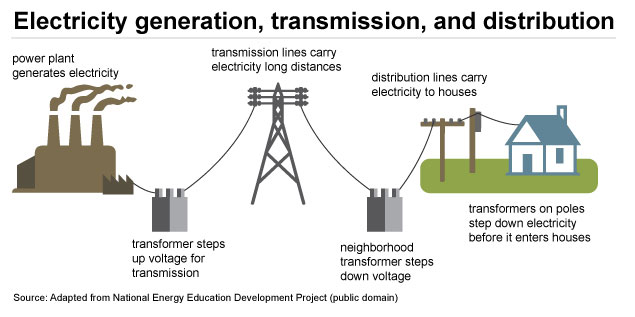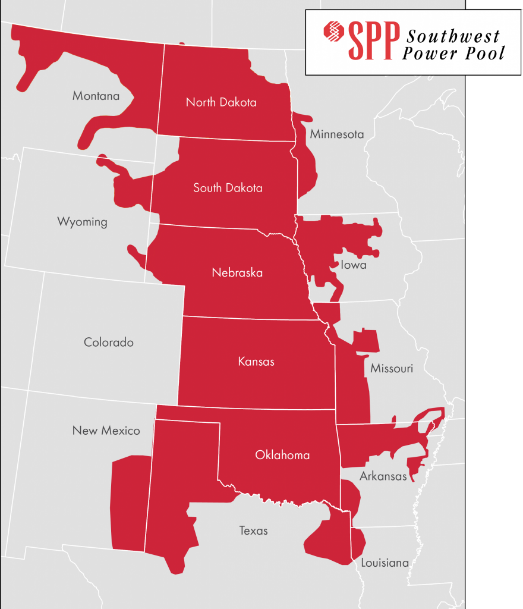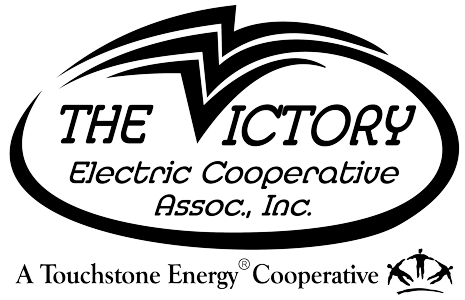
Imagine what your job would be like if you could not store your product – not even for a short period of time until a transport truck arrives. If you are a farmer or a manufacturer, imagine if the grain you grow or the milk your cows produce, or the widgets you build had to instantly go from harvest or production to immediate consumption. Lastly, imagine the demand for your product never stops and can vary wildly throughout the day, but you always had to produce the exact right amount with no shortages or overages.
That is what electric cooperatives do every day to keep the lights shining bright.
To meet this challenge electric utilities like Victory Electric rely on a complex and interconnected electric grid to deliver power to homes and businesses across America the instant it is needed. The tricky thing about electricity is that it must be used, or moved to where it can be used, the second it is produced.
There are two parts to power supply: generating (or contracting for bulk supplies) electricity at wholesale prices and transmitting it across the electric grid to local cooperatives for distribution. The U.S. electric grid consists of hundreds of thousands of miles of high-voltage power lines and millions of miles of low-voltage power lines with distribution transformers and that together connect thousands of power plants to hundreds of millions of electricity consumers.
Electricity is generated at power plants by Generation and Transmission cooperatives (G&Ts), who transmit power generated from sources such as coal, natural gas, nuclear, wind, solar, water and biomass, through a vast grid of high-voltage lines over long distances to where consumers need it. Higher voltage electricity is more efficient and less expensive for long-distance electricity transmission. G&Ts do not provide electricity directly to consumers. Instead, they sell power generated at their facilities directly to distribution cooperatives like Victory Electric, city municipalities, and other utilities.
Distribution cooperatives are the foundation of the electric cooperative network. They are the direct point of contact with consumers like you. A local electric cooperative purchases wholesale power (from a G&T) and delivers it to consumers by reducing the voltage and transferring it to smaller distribution lines that allow it to safely travel to your local homes and businesses.
Regardless of location, it will always be a local electric utility who operates the electric distribution system connecting consumers with generation sources and the vast electric grid. However, the retail structure of the utility varies from region to region. The company selling you power may be a not-for-profit electric cooperative owned by its members, a municipal electric utility; or a private, for-profit electric utility owned by stockholders (often called an investor-owned utility).
Victory Electric's Power Supply
Victory Electric’s G&T cooperative and power supplier is Sunflower Electric Power Corporation, based in Hays, Kansas. Sunflower Electric owns and operates generation and transmission assets that crisscross 36 central and western Kansas counties. Sunflower was created in 1957 by six rural electric cooperatives in western Kansas, including Victory Electric, because they needed assurance they would have a reliable long-term power supply available to them at a reasonable cost. With the original goal of providing power to their six member distribution cooperatives at a price lower than each individual cooperatives could obtain on its own, today Sunflower Electric continues to be responsible for purchasing and generating power to serve the needs of all six members.
Sunflower’s transmission system contains more than 1,000 miles of transmission line, which is a combination of 34.5 kV and 115 kV high-voltage transmission lines. A dedicated line crew maintains Sunflower’s complex transmission in coordination with the system control center to ensure reliable power is generated and delivered to Victory Electric and Sunflower’s other wholesale customers.
If an outage occurs due to a problem with a distribution substation, line, or equipment, the crews from Victory Electric repair the problem and restore power. If an outage occurs due to a problem with the high voltage transmission system, Sunflower Electric’s crews are responsible for repairs and fixing the problem.
Transmission towers, lines and equipment typically supply power to multiple transmission substations, and while transmission systems seldom fail, they are susceptible to damages from weather, critters and equipment failure just like a distribution system. They also supply electricity to large numbers of consumers and to large geographic areas, therefore transmission outages tend to be larger and more widespread than distribution system outages. Potentially, thousands of consumers could be served by one high-voltage transmission line, so these lines get attention first in the event of a large-scale, widespread outage.
Looks and weather can be deceiving. While everything in our area may look fine, there could be a storm a long distance away that caused extensive damage. It is often hard for Victory Electric to explain to our members that we don’t even know the cause of an outage, and that we are waiting for more information from our power suppliers. Most members automatically assume since we supply them with power, we should be out there fixing it. But as mentioned earlier in this section, we don’t generate our power, we just distribute it to consumers in our local service area. That means the electricity has to come from somewhere, i.e. the electric transmission system.
For perspective, imagine your local grocery store, and sole local supplier of milk and eggs, had a refrigeration unit fail, which prevented them from selling you any milk and eggs. Naturally, you would not think of personally going to the grocery store to fix the refrigerator because you don’t own it and you aren’t responsible for the repair and maintenance. You would have to wait until they made repairs and restocked the milk and eggs before you could buy more. It is the same with Victory Electric. We do not own the transmission lines––that is simply the method in which they deliver and we receive our product. When something goes wrong, we have to wait until repairs are made and power is flowing again before we can resume the flow of power and provide your home or business with electricity. In addition, crews working on transmission lines have specialized training and an understanding the dangers of working with high-voltage equipment, large equipment to reach larger structures, and the proper equipment and gear rated for higher voltages is mandatory. For the safety of Victory Electric personnel, we let Sunflower make the repairs or if our crews are able to lend a hand, trained Sunflower crews are on site.
 Sunflower Electric falls under the jurisdiction of the Southwest Power Pool (SPP), a regional transmission organization (RTO) responsible for overseeing the administration of the bulk electric grid and wholesale power market in the central United States on behalf of a diverse group of utilities and transmission companies in 14 states. SPP is responsible for ensuring the reliable supply of power, adequate transmission infrastructure, and competitive wholesale electricity prices for a 546,000-square-mile region including more than 60,000 miles of high-voltage transmission lines.
Sunflower Electric falls under the jurisdiction of the Southwest Power Pool (SPP), a regional transmission organization (RTO) responsible for overseeing the administration of the bulk electric grid and wholesale power market in the central United States on behalf of a diverse group of utilities and transmission companies in 14 states. SPP is responsible for ensuring the reliable supply of power, adequate transmission infrastructure, and competitive wholesale electricity prices for a 546,000-square-mile region including more than 60,000 miles of high-voltage transmission lines.
While all G&T utilities in these RTO markets retain ownership of their generation, transmission and distribution systems used to serve electricity to consumers, RTO’s like SPP facilitate open-access to transmission and operate the transmission system independently of, and foster competition for electricity generation among, wholesale market participants.
In March 2014, SPP launched the Integrated Marketplace (IM) as part of an ongoing effort to provide SPP members with a robust wholesale energy market. The IM, which builds on the Energy Imbalance Service market that SPP launched in 2007, consists of complex tools and processes designed to maximize cost-effective power delivery while simultaneously protecting grid reliability and relieving transmission congestion. SPP’s shift to the IM included an allowance for region-wide balancing of power supply and demand. The IM starts and dispatches the most cost-effective power generation resources to meet electric demand at any given time while ensuring that grid reliability is maintained. This revolutionary change in power delivery protocol is expected to save millions within the SPP 14-state region.
As an IM market participant, Sunflower Electric buys all energy required to meet its consumer demand from the market while simultaneously selling energy to the market produced from its generating resources. The revenue earned from selling energy to the market from Sunflower’s generators helps offset the cost of energy used to meet Sunflower’s demand. The IM also includes provisions to ensure all transmission owners within SPP, such as Sunflower, retain the value associated with their transmission assets. All of Sunflower’s IM transactions are made one day in advance based on their system’s estimated demand, as well as offer information associated with their generating resources. The day-ahead transactions are then trued up in real-time based on actual energy flows. What results is an integrated system of supply and demand that ultimately means a more efficient and cost-effective use of all assets within the SPP footprint.
